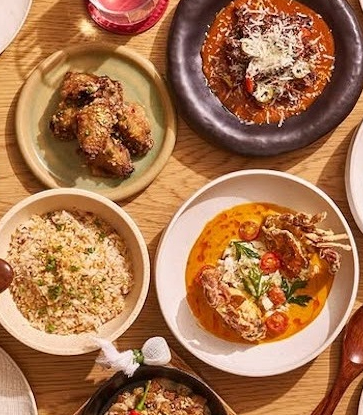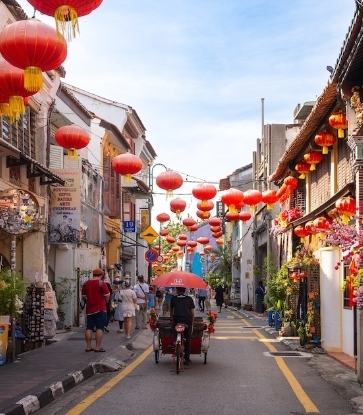The forthcoming Lunar New Year on 10 February will herald in the mighty dragon. For the Chinese the world over, noisy celebrations are being planned, with festive gatherings, where family and friends come together. Food, inevitably, will be central to most of these social occasions.
Reflecting the Chinese cultural affinity and reverence for wealth, prosperity, and success in business, Lunar New Year food items oftentimes take on names and symbolisms that underline these elements. The Chinese are also strong believers in auspicious-sounding words that carry connotations of good luck and good fortune.
Here are some of the celebratory dishes that usually make an appearance on the banquet tables during Lunar New Year:

1. Yu Sheng or Yee Sang
Since the dawn of their civilisation during the Shang dynasty (1,600 BCE), the Chinese have been eating raw fish. They refer to it as “kuai sheng”, with “kuai” meaning finely-cut, whilst “sheng” referring to the raw fish meat. The practice of eating raw fish during Lunar New Year celebrations would have evolved from this.
Today, yu sheng or yee sang is typically served in Cantonese restaurants during the Seventh Day of the Lunar New Year, or “Ren Ri” (The Day of Man). Diners would typically gather around a large platter filled with slivers of raw fish, shredded radish, carrots, pickled ginger, chopped peanuts, deep-fried flour crisps, and toasted sesame seeds, among other ingredients.
First, five-spice, ground white pepper, vegetable oil, and plum sauce are ceremoniously added to the mix, while Chinese idioms invoking prosperity, longevity, and luck are recited. Then, pandemonium reigns as — to loud shouts of “lo hei” — everyone at the table would dip their chopsticks into the mixture and “lift up” the contents as high into the air as they could, symbolising an abundance of good fortune.
Singapore lays claim to having invented the modern-day yu sheng as we know it, crediting the legendary “Four Heavenly Kings” of Chinese cuisine in the city-state by standardising the recipe and serving it at their respective restaurants in 1963: Sin Leong (at his eponymously-named restaurant), Hooi Kok Wai (Dragon Phoenix), Tham Yui Kai (Lai Wah), and Lau Yoke Pui (Red Star).
Malaysians would beg to differ, attributing its creation just after World War II to Loke Ching Fatt, who’d served it at his eatery, Loke Ching Kee, in a little town called Seremban, an hour’s drive south of Kuala Lumpur.
Regardless of who was responsible for coming up with this indispensable delicacy, Yu Sheng or Yee Sang continues to delight and entertain our tastebuds, as well as elevate our enjoyment of Lunar New Year celebrations through its cheeky, attention-grabbing demand for every diner’s involvement. One simply cannot sit out a “lo hei” session!
Where to Enjoy Yee Sang or Yu Sheng in Kuala Lumpur & Penang: Sek Yuen (Bib Gourmand, MICHELIN Guide Kuala Lumpur & Penang 2024), Elegant Inn (Selected Restaurant, MICHELIN Guide Kuala Lumpur & Penang 2024), Li Yen (Selected Restaurant, MICHELIN Guide Kuala Lumpur & Penang 2024)
Where to Enjoy Yee Sang or Yu Sheng in Singapore: Putien (Kitchener Road) (One MICHELIN Star, MICHELIN Guide Singapore 2023), Crystal Jade Golden Palace (Selected Restaurant, MICHELIN Guide Singapore 2023), Tung Lok Signatures (Clarke Quay) (Selected Restaurant, MICHELIN Guide Singapore 2023), Majestic (Selected Restaurant, MICHELIN Guide Singapore 2023)

2. Poon Choi
Legend has it that the poon choi was invented during the late Song Dynasty. To escape marauding Mongol invaders, the young Ming Emperor sought refuge southwards in an area that was to be modern-day Guangdong. There, loyal villagers pooled together the best foodstuff they had in large basins to feed the Emperor’s retinue.
From its humble beginnings born out of adversity, the poon choi today has been elevated to become a luxurious, celebratory dish, breathtaking in its contents as well as its presentation.
Characteristically, the ingredients for a poon choi are layered within a large cooking vessel: fat discs of white radish at the bottom, to prevent the dish from burning during the long stewing process. The white radish would also absorb the flavours of the stew and, as it tenderises, become much sought-after chunks of sheer deliciousness.
Layered above the radish would be pork, chicken, pig tendons, and dried mushrooms, whilst the top layer would consist of various luxury ingredients: abalone, sea cucumber, fish maw, tendons, and prawns. Each ingredient is selected to lend its savouriness and sweetness to the entire completed dish.
Poon Choi’s size and richness in ingredients symbolise abundance, as well as togetherness, as everyone in a banquet table would share in the partaking of the dish.
Where to Enjoy Poon Choi in Kuala Lumpur & Penang: Sek Yuen (Bib Gourmand, MICHELIN Guide Kuala Lumpur & Penang 2024), Elegant Inn (Selected Restaurant, MICHELIN Guide Kuala Lumpur & Penang 2024), Yun House (Selected Restaurant, MICHELIN Guide Kuala Lumpur & Penang 2024)
Where to Enjoy Poon Choi in Singapore: Lei Garden (One MICHELIN Star, MICHELIN Guide Singapore 2023), Putien (Kitchener Road) (One MICHELIN Star, MICHELIN Guide Singapore 2023), Summer Palace (One MICHELIN Star, MICHELIN Guide Singapore 2023)

3. Whole Steamed Fish with Ginger & Scallions
For the Cantonese, a whole steamed fish is usually the piece de resistance of a formal dinner. The whole fish, served with its head and tail intact, symbolises a good beginning and ending for the upcoming year.
To obtain the perfect rendition of this dish, the fish has to be absolutely fresh. Its cooking has to be perfectly-timed — the Cantonese believed a fish should be “just cooked” so that the flesh sticks to the fishbones and is never raw in any part.
Julienned ginger is scattered atop the fish before steaming. Upon its removal from heat, the freshly cooked fish is topped with fresh scallions, before sizzling hot oil is poured over it. The finishing touch is a light sprinkle of soy-sauce-sugar-water dressing.
Where to Enjoy Whole Steamed Fish in Kuala Lumpur & Penang: Elegant Inn (Selected Restaurant, MICHELIN Guide Kuala Lumpur & Penang 2024), Li Yen (Selected Restaurant, MICHELIN Guide Kuala Lumpur & Penang 2024), Yun House (Selected Restaurant, MICHELIN Guide Kuala Lumpur & Penang 2024)
Where to Enjoy Whole Steamed Fish in Singapore: Imperial Treasure Fine Teochew Cuisine (Orchard) (One MICHELIN Star, MICHELIN Guide Singapore 2023), Lei Garden (One MICHELIN Star, MICHELIN Guide Singapore 2023), Jade (Selected Restaurant, MICHELIN Guide Singapore 2023)

4. Lap Mei Fan
Lap Mei Fan, or preserved meat rice (usually cooked in a Chinese claypot), is another common sight on dining tables during the Chinese New Year. A carry-over from the old, pre-refrigeration days, the use of preserved meats during the end of winter Lunar New Year season transitioned from being a necessity to becoming a culinary tradition.
The most popular forms of “lap mei” are Chinese waxed sausages (the pork version or “lup cheong”, and duck-liver ones or “yun cheong”, are especially popular), waxed duck, and waxed pork.
Carefully sliced preserved meats are placed on rice halfway through the cooking process, in order for the meat drippings and aroma to infuse the rice.
Where to Enjoy Lap Mei Fan in Kuala Lumpur & Penang: Elegant Inn (Selected Restaurant, MICHELIN Guide Kuala Lumpur & Penang 2024)
Where to Enjoy Lap Mei Fan in Singapore: Lei Garden (One MICHELIN Star, MICHELIN Guide Singapore 2023), Jade (Selected Restaurant, MICHELIN Guide Singapore 2023), Jade Palace (Selected Restaurant, MICHELIN Guide Singapore 2023)

5. Nian Gao
In Chinese, Nian Gao, literally means "high year", hoping that each year's achievements surpass that of the year before.
Modern-day renditions of the Nian Gao in Singapore now include pandan or black sesame flavoured ones.
Where to Enjoy Nian Gao in Kuala Lumpur & Penang: Elegant Inn (Selected Restaurant, MICHELIN Guide Kuala Lumpur & Penang 2024), Li Yen (Selected Restaurant, MICHELIN Guide Kuala Lumpur & Penang 2024), Yun House (Selected Restaurant, MICHELIN Guide Kuala Lumpur & Penang 2024)
Where to Enjoy Nian Gao in Singapore: Imperial Treasure Fine Teochew Cuisine (Orchard) (One MICHELIN Star, MICHELIN Guide Singapore 2023), Crystal Jade Golden Palace (Selected Restaurant, MICHELIN Guide Singapore 2023), Tunglok Signatures (Clarke Quay) (Selected Restaurant, MICHELIN Guide Singapore 2023)

6. Ho See Fatt Choy
This is a classic Cantonese dish of braised dried oysters, pronounced “ho see” in Cantonese, which sounds like “good things”; and black moss, whose name, “fat choy” sounds like “prosperity”. Put together, the dish’s auspicious term augurs well the upcoming year’s business.
Most Cantonese restaurants would also add other ingredients to complement this dish such as abalone, fish maw, and dried Chinese mushrooms.
Where to Enjoy Ho See Fatt Choy in Kuala Lumpur & Penang: Elegant Inn (Selected Restaurant, MICHELIN Guide Kuala Lumpur & Penang 2024), Li Yen (Selected Restaurant, MICHELIN Guide Kuala Lumpur & Penang 2024), Yun House (Selected Restaurant, MICHELIN Guide Kuala Lumpur & Penang 2024)
Where to Enjoy Ho See Fatt Choy in Singapore: Lei Garden (One MICHELIN Star, MICHELIN Guide Singapore 2023), Jade (Selected Restaurant, MICHELIN Guide Singapore 2023), Yì By Jereme Leung (Selected Restaurant, MICHELIN Guide Singapore 2023)

7. Bubur Cha Cha
A Lunar New Year dish unique to Malaysia and Singapore is Bubur Cha Cha, a sweet dessert usually prepared by the Strait Chinese, also known as Peranakans or Babas and Nyonyas in Malacca, Penang, and Singapore.
Bubur Cha Cha consists of sweet potato, taro, black-eyed beans, and chewy tapioca jelly in a sweet, pandan-scented coconut milk soup.
It is a colourful celebratory dish that the 500-year-old Peranakan community had adapted from the Malays, who make a simple “pengat”, which is a sweet dessert of either cassava, taro, or banana, cooked in sweetened coconut milk.
The Peranakans made it more elaborate and colourful by putting various types of root vegetables, plus black-eyed beans, and tapioca jelly, into the pot together all at once. Its richness symbolises abundance and prosperity for the upcoming year.
Where to Enjoy Bubur Cha Cha in Kuala Lumpur & Penang: Auntie Gaik Lean’s Old School Eatery (One MICHELIN Star, MICHELIN Guide Kuala Lumpur & Penang 2024), Bibik’s Kitchen (Bib Gourmand, MICHELIN Guide Kuala Lumpur & Penang 2024), Ceki (Selected Restaurant, MICHELIN Guide Kuala Lumpur & Penang 2024)
Where to Enjoy Bubur Cha Cha in Singapore: Indocafé - The White House (Bib Gourmand, MICHELIN Guide Singapore 2023)
All images are from Shutterstock.





















